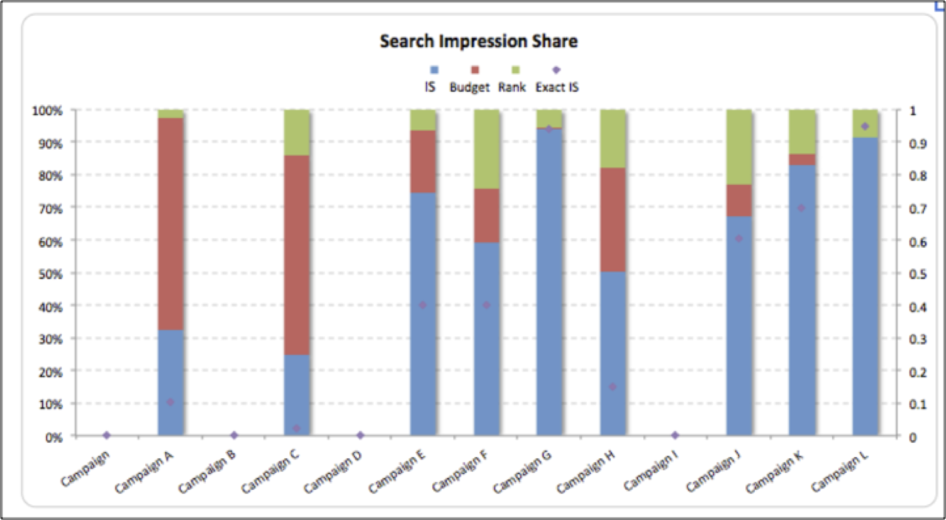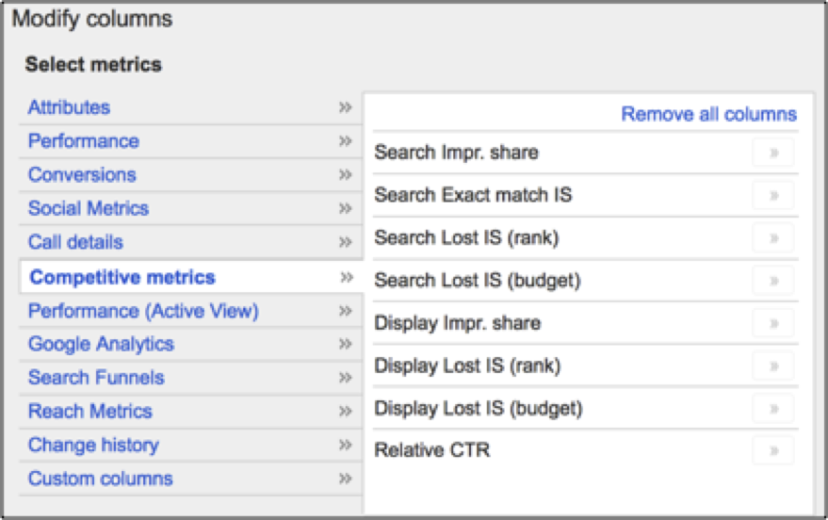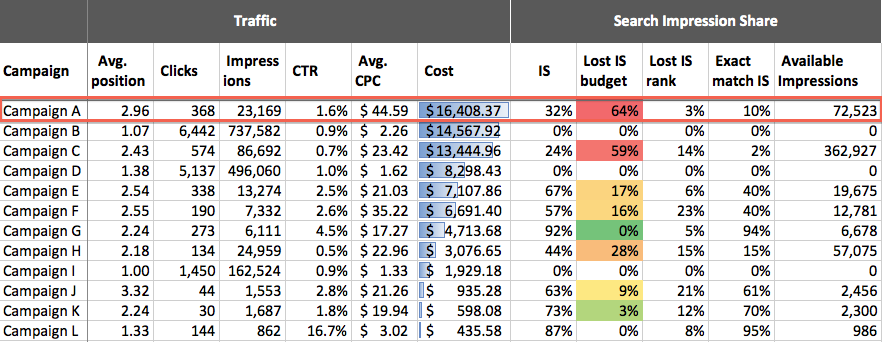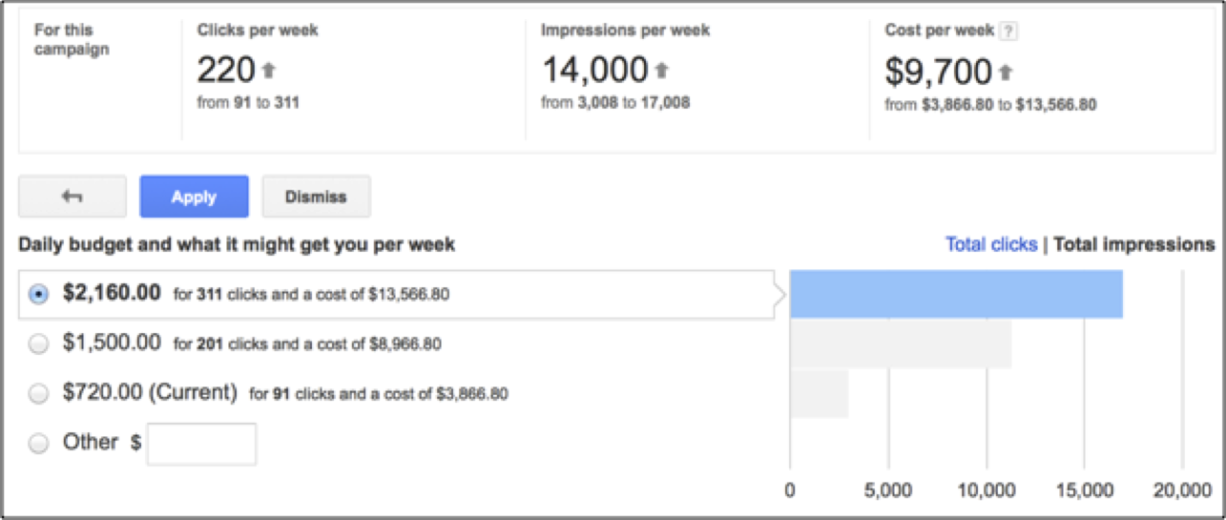Two questions that we get asked frequently are:
- How much more should I spend for our PPC account?
- How many more conversions can I expect to get from the increase in spend?
When asked these questions the first thing I look at is what campaigns are performing well and how much impression share is being lost. However, analyzing impression share can be a bit cumbersome and confusing when trying to determine how to recoup those lost impressions. Below, we will dissect the various forms of impression share metrics, show how to calculate incremental conversion opportunities lost to budget and ideas to help improve total impression share.
Whether you are looking at AdWords Impression Share or Bing Ads Share of Voice, these metrics are a great way to check the overall campaign health and strength of your keyword set. If you have high exact match IS that probably means you have great coverage on those terms. A low impression share means you are potentially leaving money on the table and further optimizations are necessary.
Once you’ve identified loss impression share and start to dig into the maze of why and where, it can really start to get confusing and complex. Is the impression share loss for Search or Display? Why is search exact match IS so low? Is the lost search impression share due to rank or budget?
All of these metrics are important to understand. So before diving right into calculating estimated incremental conversions opportunities, let’s quickly review what each of the metrics are and what they mean.
Impression Share Metrics Explained
- Search impression share: The impressions you’ve received on the Search Network divided by the estimated number of impressions you were eligible to receive.
- Display impression share: The impressions you’ve received on the Display Network divided by the estimated number of impressions you were eligible to receive.
- Search Lost IS (budget): The percentage of time that your ads weren’t shown on the Search Network due to insufficient budget. This data is available at the campaign level only.
- Display Lost IS (budget): The percentage of time that your ads weren’t shown on the Display Network due to insufficient budget. This data is available at the campaign level only.
- Search Lost IS (rank): The percentage of time that your ads weren’t shown on the Search Network due to poor Ad Rank in the auction. Note: Lost IS (rank) won’t be shown on your ad groups tab if you ran out of budget at any point during the date range being examined.
- Display Lost IS (rank): The percentage of time that your ads weren’t shown on the Display Network due to poor Ad Rank. Note: Lost IS (rank) won’t be shown on your ad groups tab if you ran out of budget at any point during the date range being examined.
- Search Exact match IS: The impressions you’ve received divided by the estimated number of impressions you were eligible to receive on the Search Network for search terms that matched your keywords exactly (or were close variants of your keyword). Not available for Shopping campaigns.
Now that we have a better understanding of what each of the metrics mean, let’s figure out how much more would it cost to gain impression share lost to budget and estimated incremental conversion opportunities.
Calculate Incremental Conversion Opportunities Lost to Budget
First start by pulling a campaign report that includes all the competitive metrics and then segment by day. For this example, I used the last 30 days time frame.
Next, I placed the data in a pivot table with traffic KPIs and segmented by campaign to get a better idea of which campaigns were losing the most IS. Below is graph to help visually analyze impression share.
Campaigns A and C have the highest lost IS due to budget, while campaigns F and J have the highest lost IS due to rank. Now that we’ve identified which campaigns have the most opportunity to improve impression share, the next questions are typically “What is that going to cost and how many conversions can you expect by increasing impression share?”
Before we can determine incremental spend and conversion opportunities, we need to first determine total available impressions for each campaign. To do this we use the formula below:
Let’s use Campaign A (Search) as the example.
Available Impressions: Impressions (23,169) / (IS (32%) = 72,523
Next, we look at conversions and what if Lost IS Budget = 0%.
Assuming no ad testing, new keywords or any other optimizations have been implemented, CTR, CPCs, Conv. Rates and AOV should remain relatively consistent. Keeping that in mind, we are able to back-out the incremental opportunities as follows:
- Impressions = Lost IS Budget % (64%) * Available Imp (72,523) = 46,102
- Clicks = Inc. Imp (46,102) * CTR (1.6%) = 732
- Cost = Inc. Clicks (732) * Avg. CpC ($44.59) = $32,649.33
- Conv = Inc. Clicks (732) * Conv. Rate (.82%) = 6
In the example above we did not track revenue but you could get an estimate for revenue by taking the AOV * Inc. Conv = Inc. Revenue.
If you are not an Excel junkie and prefer the usability of the interface to get a better estimate of opportunities for increasing your traffic, the Opportunities tab also provides estimates for incremental spend and traffic. Or the AdWords Keyword Planner is another tool that helps provide traffic estimates for specific keywords.
While improving lost impression share due to rank is equally important, it is more complex to forecast, as CPCs and CTR should increase as your rank improves. Therefore calculating projections for incremental gains by improving rank will need some additional research for a follow-up article.
Now that we have a better understanding of what is being left on the table, what can we do to recoup impression share?
How To Improve Lost Impression Share
Budget
When impression share is lost to budget the simple solution would be to simply increase the budget. However, that might not be an option. Below are several optimizations to implement to help improve impression share lost to budget:
- Make sure profitable campaigns are not capped by budget
- Day-parting/ad scheduling
- Geo-targeting
- Add negatives to exclude unwanted traffic
- Device bid modifiers
- Review Google Trends to help understand market trends on specific terms
Rank
Google recently changed the way Ad Rank is calculated to include ad formats into the calculation. Now the Ad Rank formula includes Max CpC, Quality Score AND Ad Extensions. Focusing on these key elements should help improve lost impression share due to rank:
- Increase quality score
- Implement and optimize ad extensions
- Bid optimizations
- Review auction insights to see what competitors you are competing with
Takeaways
Impression share is a metric that helps get a pulse on the health of your account by seeing what percentage of auctions your campaigns are actually showing for. If your campaigns have low impression share, there is likelihood that you could be missing out on opportunities for incremental conversions and revenue. While there are several ways to help project incremental gains in impression share, the main elements for improving impression share seem to come down to quality score, max CPC, ad extensions and budget.
What other methods have you found helpful for analyzing and projecting impression share?








